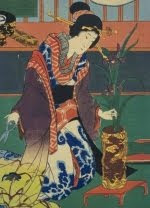It's often said that you should choose one ikebana School and then stay faithful to your choice. I remember my teacher advising me to concentrate on Sogetsu ikebana rather than comparing it too much with other schools. Trying to grasp the many rules and styles of different schools would be like studying several languages at the same time. The focus may get too broad and the whole situation confusing. Still I can't help being fascinated by the differences. I'm especially intrigued by the old classic schools. I find that their teaching enriches my understanding also of modern ikebana.
Lately I've been reading "Heaven and Earth are Flowers: Reflections on Ikebana and Buddhism" by Joan D. Stamm. This is a quite new book. I've been reading it really slowly allowing it to stimulate my own reflections while reading. Joan Stamm is an authorized teacher of the Saga School, a school that traces its traditions back to more than 1200 years and has as it's motto "to unite flowers and religion". She merges stories from everyday experiences with the wisdom of Buddhist philosophy, traditional ikebana, and insights learned from living the way of flowers.
Finding a place for the book in my bookshelf I feel grateful for stories that are shared and teachings that are handed down. I'll place it together with Gustie L. Herrigel's book "Zen in the Art of Flower Arranging" sharing her gradual understanding of ikebana and buddhism in the 1920's Japan, and a book by the Swedish author Ida Trotzig telling the story of her life in Japan in the early 1900's and her fascination with ikebana that, as for Joan Stamm, started with a visit to the old temple Daikaku-ji.
Reading this books has been stimulating. I know I'll keep exploring the balance of opposites in ikebana known as In Yo in Japanese and Yin and Yang in Chinese. I'll also keep thinking about the differences between Japanese and Western views on how to cultivate a humble personality.

Wisdom Publications, Boston, 2010












1 comment:
I recently attended the flower demonstrations at Downtown, Los Angeles. What was great about it was that I got to see the demonstrations by Ikenobo, Ohara, and Sogetsu at the same time, and I was able to learn how other schools arrange flowers, history, etc. After that, there was a workshop where attendees could pick a school. Just to see what kind of materials each school picked was interesting. Of course, I picked Sogetsu becasue my teacher, Yokou Kitajima, was teaching there.
(*0*)/
Post a Comment